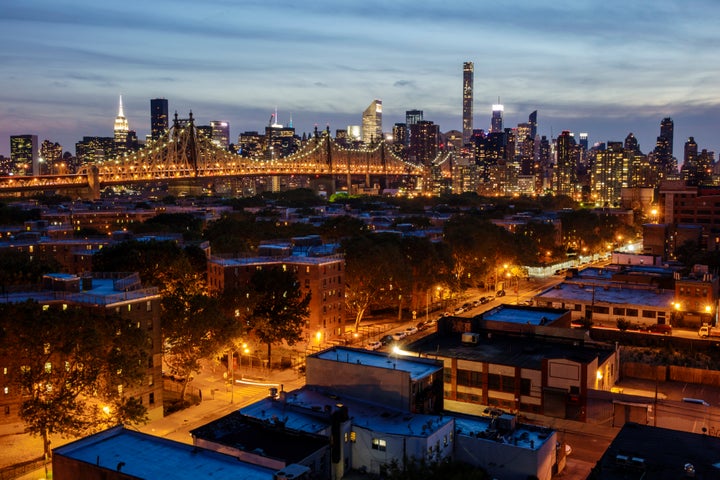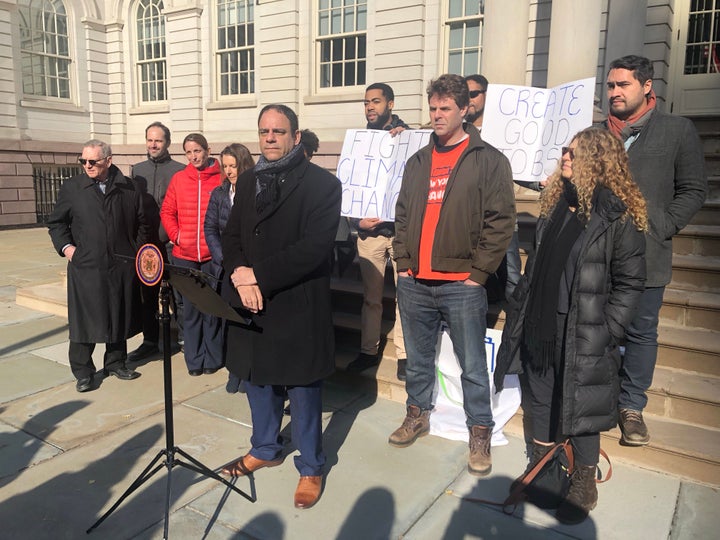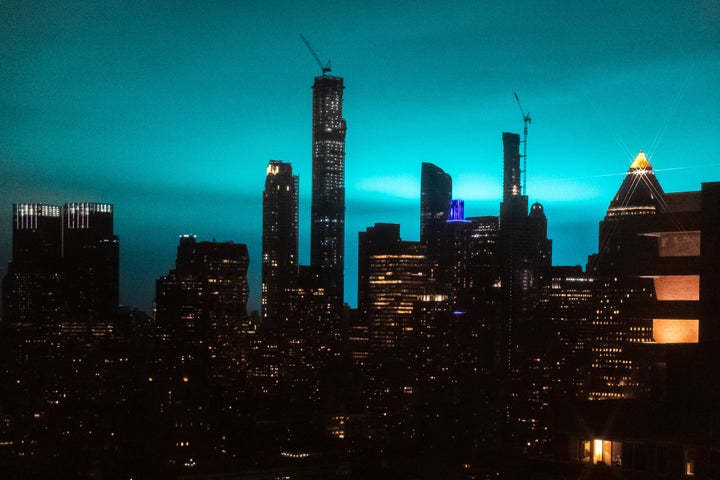
ASTORIA, N.Y. ― A top New York City councilman is preparing to introduce a bill mandating that the city come up with a plan by the end of the year to phase out nearly two dozen gas-fired power plants and replace them with renewable sources of electricity.
The legislation would require the city to carry out a study on “the feasibility of replacing existing in-city gas-fired plants with renewables that use battery storage,” according to a draft HuffPost obtained. By Dec. 30, 2019, the city would have to lay out a plan to swap those gas-fired generating stations for new wind or solar units paired with batteries.
There’s no guarantee the study will result in a workable proposal. But the impact could be huge. Of the 24 power plants in New York City, 21 burn gas, contributing to the roughly 30 percent of the city’s greenhouse gas emissions that come from the utility sector, according to city data. The other three burn petroleum, an even dirtier fuel, and would likely be affected by any policy aimed at drastically shrinking fossil fuel’s share of the city’s electricity production.
Reached by phone on Monday, Councilman Costa Constantinides, the Queens lawmaker who authored the bill, confirmed its existence but declined to comment on its details.
“Donald Trump may love power plants, but we know the 21st-century future is a green grid,” said Constantinides, who chairs the council’s Committee on Environmental Protection.
The bill, announced Tuesday and set to be introduced Wednesday, marks a significant step toward weaning the nation’s largest and most economically influential city off fossil fuels. Six cities across the United States already generate 100 percent of their electricity with renewables. The city council in Washington, D.C., passed a bill last month requiring the city to offset 100 percent of its electricity purchases with renewable energy credits by 2032. But it would be a historic first for a metropolis like New York to shutter existing gas plants like these, and the city’s move would likely ripple far beyond the five boroughs as other big cities sought ways to slash climate-changing emissions.
Some small cities have managed to shift to renewable electricity “but nothing on the scale of New York,” said David Pomerantz, executive director of the nonprofit Energy and Policy Institute, which tracks the utility sector.
It’s unclear whether an overhaul of New York’s power stations would trigger utility cost increases for ratepayers, but industry groups likely to oppose the bill are expected to argue that it would.
The legislation calls for researching at least six different types of batteries to store excess wind or solar power for times when the wind doesn’t blow and the sun isn’t shining. That would, in theory, offer the increased energy reliability needed to replace a network of gas-fired “peaker plants” on the New York waterfront. Those plants provide backup power when demand is high or there’s a malfunction at power stations upstate.

But a large share of New York City’s locally produced electricity is generated by two power plants in the densely populated northwestern corner of Queens that Constantinides represents. The plants, located in the councilman’s native Astoria and neighboring Long Island City, each burn a mix of gas and fuel oil. The stations annually burn a combined 6.3 million gallons of No. 6 fuel oil ― a thick, viscous blend considered one of the most polluting energy sources in the world. The Long Island City plant, called Ravenswood Generating Station, was ranked the state’s largest carbon polluter in 2014.
The bill’s announcement comes nearly two weeks after an equipment malfunction at a Consolidated Edison substation next door to the Astoria Generating Station released an electric arc flash that illuminated the city sky with an eerie neon blue. The accident, the result of a broken voltage monitoring system, had no direct connection to the neighboring power plant.
But the incident ― on which Constantinides is scheduled to hold a Feb. 11 hearing ― raised new concerns about the risks of burning fossil fuels for electricity in a residential neighborhood and cast a new light on existing public health problems linked to power plant pollution.
Speaking at a press conference outside a utility complex in Astoria on Tuesday morning, Constantinides said, “It’s time for a greener future here in western Queens.”
“Astoria Borealis was a spotlight on the issues of what we’re dealing with in our community,” he said.
In 2015, Astoria and Long Island City suffered from higher pollution levels than the rest of the borough and the city, according to New York City Department of Health findings. The levels of PM2.5 ― a fine-grain pollutant that wedges into lung tissue when inhaled, making it one of the most harmful types of particulate matter ― hit 8.9 micrograms per cubic meter, higher than the 8.4 average for Queens overall and the 8.6 average citywide.
Queens officials, including Constantinides, have long blamed the plants for the two neighborhoods’ high levels of asthma, which earned one part of northern Astoria the nickname “Asthma Alley.” In 2017, the city council passed legislation requiring the utility operators to stop using No. 6 fuel oil by 2020 and No. 4 oil by 2030. The new bill would be the first to lay the groundwork for phasing out the plants altogether.

Meanwhile in Albany, the new Democratic majorities in both houses of the New York Legislature are preparing to push the Climate and Community Protection Act, a bill that would mandate 100 percent renewable energy across the state by 2050. The CCPA has repeatedly passed in the state Assembly since it was first introduced in 2016, but the previous Republican majority in the state Senate refused to hold a vote on it. Gov. Andrew Cuomo (D), who now says he wants to shift the state to 100 percent carbon-free electricity by 2040, declined to champion the legislation last year.
New York state generates just 5 percent of its electricity from wind or solar. The New York City area consumes roughly 60 percent of all power in the state, but produces just 40 percent.
Democratic state Sen. Jessica Ramos, a newly elected legislator from Queens, vowed to co-sponsor the CCPA and consider other ways to provide state-level support to Constantinides’ legislation.
“We’re looking into what can be done as a state measure as we speak,” she told HuffPost on Monday. “It’s exactly what we should be doing.”
State agencies are already making a push. Last June, New York’s Department of Public Service issued a report outlining an “energy storage roadmap.” In December, the state’s Public Service Commission released a plan requiring utilities such as ConEdison to procure a total of 350 megawatts of storage as part of a broader blueprint to decrease the state’s dependence on fossil-fueled peaker plants. The New York State Energy Research and Development Authority earlier vowed to conduct a study on how to move every sector in the state to 100 percent renewable energy, although Politico reported last week that the report had not been made public by the end of 2018 as promised.
Pete Sikora, a senior adviser to the grassroots group New York Communities for Change, said it’s critical for the city to conduct its own study to put more pressure on state agencies.
“It’s all about politics,” Sikora said after Tuesday’s press conference. “And it’s important that it’s in the city’s hands.”
The power plant bill will be the second major piece of energy legislation from Constantinides in a little over five weeks. In November, he introduced legislation to cut emissions from buildings of more than 25,000 square feet by 80 percent by 2050. That would set what could be a new standard for cities around the world and form the backbone of what proponents have dubbed the “Green New Deal for New York City.”
The legislative push builds on high-profile efforts from other top City Hall officials. In December, New York City Comptroller Scott Stringer announced a “significant next step” in divesting the city’s $200 billion pension funds from the oil and gas sector as he issued a request for a proposal to analyze the city’s fossil fuel risks.
Last January, Mayor Bill de Blasio decided to sue five major oil companies over infrastructure damage linked to sea level rise. A federal judge dismissed the suit in July, but California and seven other states signed on to New York City’s appeal in November.
Pomerantz, of the Energy and Policy Institute, suggested that the deadline in the power plant bill is key.
“The question of speed makes all the difference in the world for climate change,” he said. “If New York City is serious about its climate goals, that’s exactly what it needs to do, is look at the question and say, ‘How quickly can we get out of gas and into renewables?’”
This story was updated with details from the press conference and comment from Pete Sikora.
